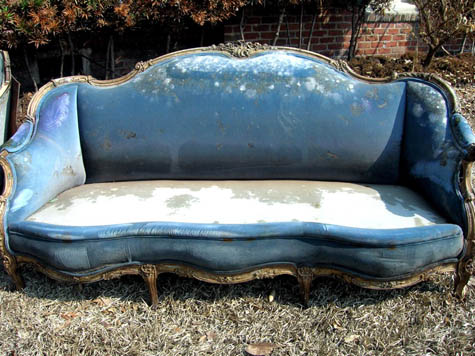Pushkin Park
 [Image: A moldy sofa, otherwise unrelated to this post, photographed by Flickr user melinnis – who also made this awesome image].
[Image: A moldy sofa, otherwise unrelated to this post, photographed by Flickr user melinnis – who also made this awesome image].Russian scientists have begun testing blood stains on the sofa where novelist Alexander Pushkin is rumored to have died, in order to determine if those stains might have come from Pushkin himself.
At least two things interest me here:
1) It's the forensic sciences applied to antique furniture in order to find the otherwise undetectable remains of a dead Russian novelist. One might even say residue here, not remains at all; it is the barest of traces. Suddenly, though, it's as if those old stuffed sofas, fading carpets, and tables of hand-worn wood in obsolete interiors around the world have been transformed into a kind of archaeological site, in which the chemical traces of literary history might yet be discovered. The sofa is Pushkin's Calvary, if you will – a chemical reliquary. Furniture becomes a kind of hematological Stargate into literature's mortal past. Who else might they find in there? You go around the world performing genetic tests on antique furniture to see which novelists ever used it – traces of Sebald, Hemingway, Tolstoy.
2) Two words: Pushkin Park. We clone Pushkin and start a theme park. Like a thousand Mini-Me's well-versed in storycraft, Pushkin – one man distributed through a thousand bodies – wanders the artificial landscape, and like some strange Greek myth wed with Antiques Roadshow, he tells the crowds, "I sprung forth, fully formed, from a sofa..." And there begins a tale for stunned tourists.
(Via the Guardian).





Comments are moderated.
If it's not spam, it will appear here shortly!
Hey there. Not Pushkin Park related, but yesterday I bought a book that made me think of BLDGBLOG: http://art-service.de/article/heterotopia_arbeiten_von_willem_van_genk_und_anderen.html - it's the catalog of an exhibition at the German Museum of Architecture in Frankfurt, about the spatial imagination of - primarily - people with psychological difficulties. This is the museum's page about the exhibition: http://www.dam-online.de/portal/WebObjects/PortalDAM.woa/wa/select?id=190005598&entity=Artikel (sadly, the page does not seem to be available in English.) There are some pretty amazing pictures in that book, especially if you're interested in the interrelations between the human psyche and the built environment (and the imagination of the built environment.)
Maybe it is also because he died of a duel's wounds... so they expect to find some blood on this sofa... which might not be the case with usual day-to-day furniture.
Or perhaps these stains are not just deposits of a person’s DNA but contain records of their own creation.
The subject of stains in this context, as archeological sites, is really fascinating and worth a closer look. It’s of particular fascination for me when exploring abandoned places. Stains may be the last thing a person leaves behind in this world – a soiled mattress, crust on a long disused autopsy slab - and for that reason they can take on a certain psychological significance which is of course completely open to fictitious interpretation. They can be read like a map to a person's particular trauma, a struggle with ordinary motor control or a moment of pleasure. Abandoned buildings can be entire landscapes of these stains, forming interwoven narratives, assuming lives of their own, assembling into the larger geography of a building’s decay, becoming little centerpieces in the micro-dioramas of sprouts and ceiling debris collecting over years on a hospital bed….
You might have to bring in a medium or a good storyteller to interpret these, rather than forensic scientists.
Thank you for the post.
In the Miracleman comic book collection "The Golden Age" there was a whole underground full of Andy Warhol clones.
I could easily imagine a similar land of Pushkins
Post a Comment